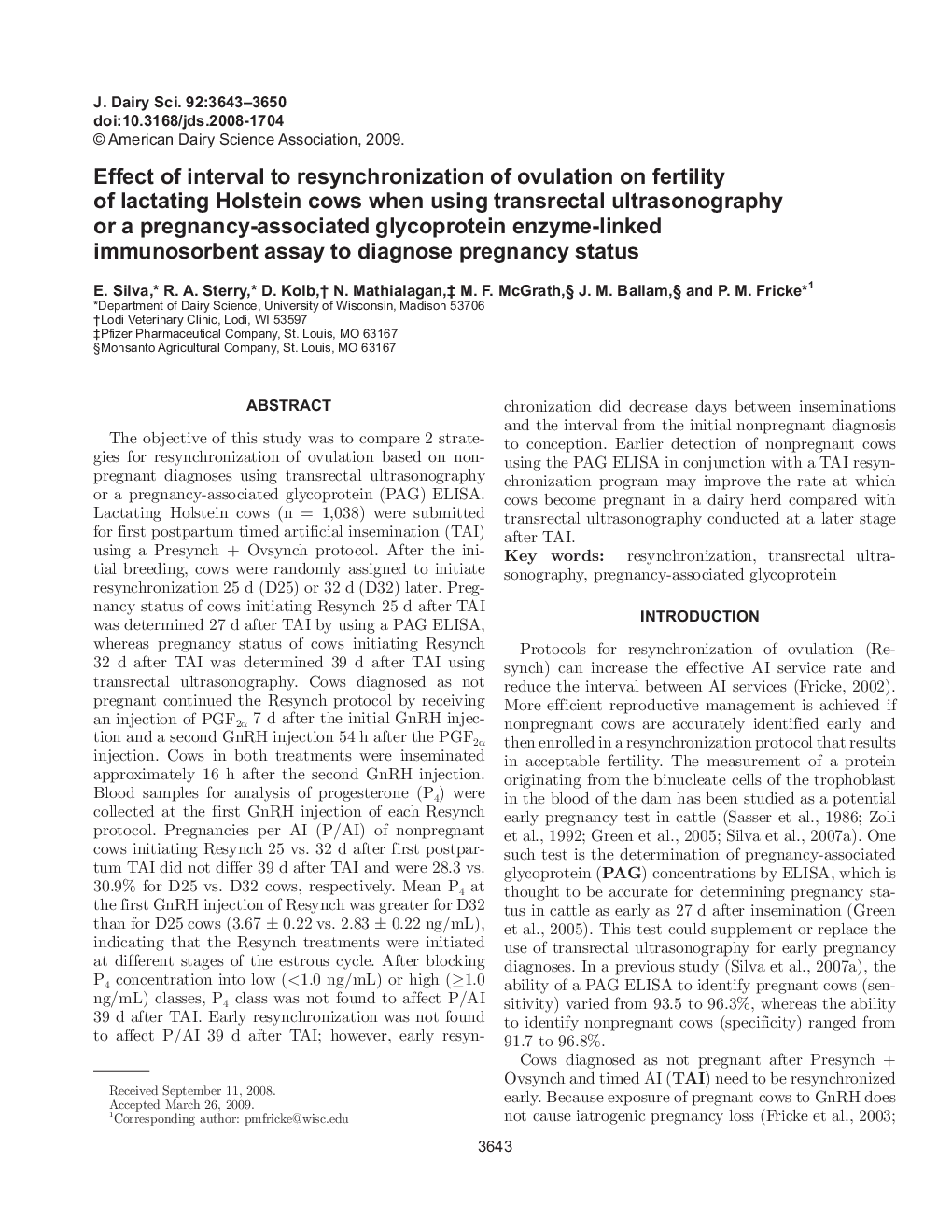| کد مقاله | کد نشریه | سال انتشار | مقاله انگلیسی | نسخه تمام متن |
|---|---|---|---|---|
| 2439043 | 1108086 | 2009 | 8 صفحه PDF | دانلود رایگان |
عنوان انگلیسی مقاله ISI
Effect of interval to resynchronization of ovulation on fertility of lactating Holstein cows when using transrectal ultrasonography or a pregnancy-associated glycoprotein enzyme-linked immunosorbent assay to diagnose pregnancy status
دانلود مقاله + سفارش ترجمه
دانلود مقاله ISI انگلیسی
رایگان برای ایرانیان
کلمات کلیدی
موضوعات مرتبط
علوم زیستی و بیوفناوری
علوم کشاورزی و بیولوژیک
علوم دامی و جانورشناسی
پیش نمایش صفحه اول مقاله

چکیده انگلیسی
The objective of this study was to compare 2 strategies for resynchronization of ovulation based on nonpregnant diagnoses using transrectal ultrasonography or a pregnancy-associated glycoprotein (PAG) ELISA. Lactating Holstein cows (n = 1,038) were submitted for first postpartum timed artificial insemination (TAI) using a Presynch + Ovsynch protocol. After the initial breeding, cows were randomly assigned to initiate resynchronization 25 d (D25) or 32 d (D32) later. Pregnancy status of cows initiating Resynch 25 d after TAI was determined 27 d after TAI by using a PAG ELISA, whereas pregnancy status of cows initiating Resynch 32 d after TAI was determined 39 d after TAI using transrectal ultrasonography. Cows diagnosed as not pregnant continued the Resynch protocol by receiving an injection of PGF2α 7 d after the initial GnRH injection and a second GnRH injection 54 h after the PGF2α injection. Cows in both treatments were inseminated approximately 16 h after the second GnRH injection. Blood samples for analysis of progesterone (P4) were collected at the first GnRH injection of each Resynch protocol. Pregnancies per AI (P/AI) of nonpregnant cows initiating Resynch 25 vs. 32 d after first postpartum TAI did not differ 39 d after TAI and were 28.3 vs. 30.9% for D25 vs. D32 cows, respectively. Mean P4 at the first GnRH injection of Resynch was greater for D32 than for D25 cows (3.67 ± 0.22 vs. 2.83 ± 0.22 ng/mL), indicating that the Resynch treatments were initiated at different stages of the estrous cycle. After blocking P4 concentration into low (<1.0 ng/mL) or high (â¥1.0 ng/mL) classes, P4 class was not found to affect P/AI 39 d after TAI. Early resynchronization was not found to affect P/AI 39 d after TAI; however, early resynchronization did decrease days between inseminations and the interval from the initial nonpregnant diagnosis to conception. Earlier detection of nonpregnant cows using the PAG ELISA in conjunction with a TAI resynchronization program may improve the rate at which cows become pregnant in a dairy herd compared with transrectal ultrasonography conducted at a later stage after TAI.
ناشر
Database: Elsevier - ScienceDirect (ساینس دایرکت)
Journal: Journal of Dairy Science - Volume 92, Issue 8, August 2009, Pages 3643-3650
Journal: Journal of Dairy Science - Volume 92, Issue 8, August 2009, Pages 3643-3650
نویسندگان
E. Silva, R.A. Sterry, D. Kolb, N. Mathialagan, M.F. McGrath, J.M. Ballam, P.M. Fricke,